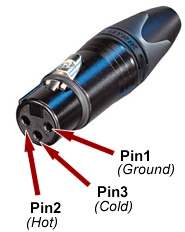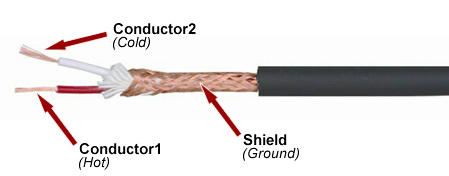What is a Mic Level Signal?
All pro audio microphones output what is known as a microphone level signal. This is a low impedance (Low-Z), low voltage signal ranging typically from 200ohm to 1000ohm, carried on a microphone cable with 3-pin XLR connectors. These mic level signals are typically encountered as a balanced type, using standard mic cables that support two signal conductors and a shield. The images below show the pinout of a typical XLR connector and the internal wiring structure of a balanced microphone cable.


How Microphones Capture Sound
A microphone works by detecting the differences in air pressure when you sing or record an instrument. The signal produced by the air pressure fluctuations is weak, and therefore any interference is very noticeable within the signal. For this reason, microphones output what is known as a balanced microphone signal, which has the effect of cancelling out interference picked up along the cable — provided the mic is plugged into a balanced input such as a mixing desk mic input.
Why Balanced Mic Signals Matter
Because of the interference rejection provided by balanced microphone signals, microphone cables can be run in long lengths. Multicore cables, often with stage boxes attached at one end, are really just many lengths of balanced microphone cable bound together and can be as long as 70m. Running a mic signal a long length will result in a small amount of signal loss, but it is generally not an issue due to the fact that all mic signals are later boosted by a preamp.
Mic Level vs Line Level
Once the mic signal arrives at the mixing desk it is hopefully free of interference noise, but will require the preamp to boost the microphone level signal up to an appropriate level for the mixing desk and other audio processing equipment to use. This boosted signal is known as a 'Line Level' signal. Mic level signals are typically -60 dBV, while line level signals are around 0 dBV. Connecting a mic directly to a line-level input without amplification will result in a weak, barely audible signal.
The Role of Microphone Preamps
Microphone preamps boost low-level mic signals to usable levels. Some are built into mixing desks, others exist in standalone units or audio interfaces. Matching impedance is key for optimal performance — the microphone's output impedance should be close to the input impedance of the preamp. Some preamps allow users to adjust impedance to suit different microphones. Proper gain adjustment ensures clarity and avoids distortion or feedback.
Mic Impedance and Gain Considerations
Microphones, similar to speakers, perform best when the impedances are matched. That is to say, the output impedance of the microphone should match, or be as close as possible to the rated impedance of the preamp input. Some preamps have a control to adjust the impedance of the input to better suit different microphones.
There is a direct relationship between the sensitivity of the microphone and the level of gain required on the preamp. It is important to adjust the gain to an appropriate level for each microphone to ensure optimal performance and minimise the risk of feedback.














